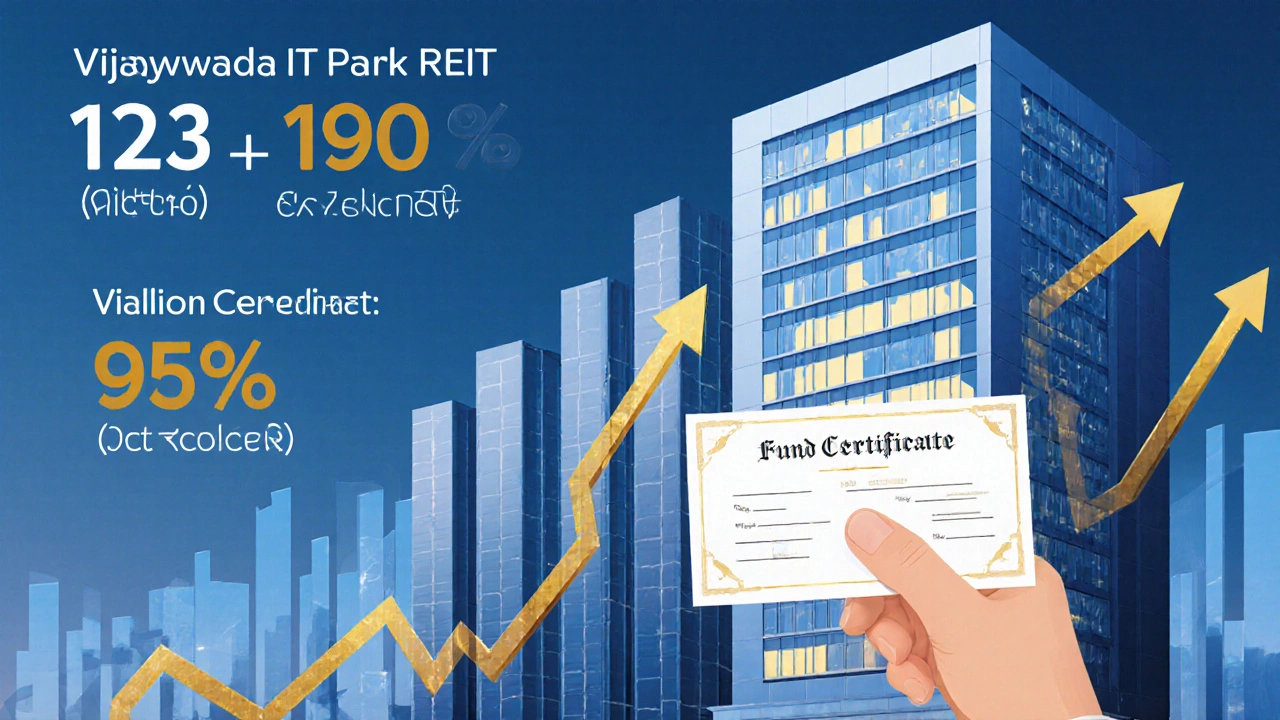Real Estate Investment Calculator for Vijayawada
Investment Estimate Calculator
Estimate your potential returns from real estate investment funds in Vijayawada based on different fund types and investment periods.
Note: Estimates based on average returns for Vijayawada real estate funds as described in the article (REIT: 6-9%, Mutual Fund: 5-7%, Direct Property: 8-12%). Actual returns may vary based on market conditions and fund performance.
Thinking about putting money into property but unsure how to start in Vijayawada? Real estate investment funds let you own a slice of the city’s booming market without buying a whole building. This guide walks you through what these funds are, who runs them, the rules that keep them safe, and how to pick the right one for your goals.
Quick Takeaways
- Real estate investment funds pool money from many investors to buy commercial or residential assets.
- In Vijayawada, most funds are either REITs or real‑estate‑focused mutual funds registered with SEBI.
- Minimum investment typically ranges from ₹10,000 to ₹50,000, making entry easy for first‑time investors.
- Returns come from rental income and capital appreciation, reported through the fund’s NAV.
- Tax benefits include lower capital‑gains rates and possible deductions under Section 80C.
What Is a Real Estate Investment Fund?
Real estate investment fund is a pooled investment vehicle that buys, manages, and sells property on behalf of its investors. The fund’s assets can be office towers, shopping malls, residential complexes, or even land parcels. By sharing ownership, investors enjoy diversification and professional management that would be impossible with a single property purchase.
Why Vijayawada?
Vijayawada is fast becoming the commercial hub of AndhraPradesh. The city’s population grew by 22% over the past five years, and the government’s push for smart‑city projects has spurred demand for office space and retail outlets. These trends translate into steady rental yields-often 6‑8% annually-and solid upside as infrastructure improves.
Key Types of Funds Available
There are three main categories you’ll encounter:
- REIT (Real Estate Investment Trust): Listed on stock exchanges, they must distribute at least 90% of net income to shareholders. REITs focus on income‑generating assets and offer high liquidity.
- Real‑estate‑focused mutual funds: Managed by asset management companies, they invest in a mix of REITs, real‑estate stocks, and direct property securities. These funds are not listed, so redemption may take a few days.
- Hybrid funds: Combine equity exposure with real‑estate holdings to smooth out volatility. They’re useful if you want a little property flavor in a broader portfolio.

Regulatory Backbone - SEBI
SEBI (Securities and Exchange Board of India) oversees all listed REITs and mutual funds. It mandates disclosure of asset quality, leverage limits, and periodic NAV statements, protecting investors from opaque practices. Before you commit, check the fund’s SEBI registration number on the official website.
How Returns Are Calculated
The fund’s performance is expressed through its Net Asset Value (NAV). NAV equals total asset market value minus liabilities, divided by the number of units. Rental income adds to the NAV, while capital gains from property sales boost it further. Some funds also pay quarterly dividends directly to unit holders.
Tax Implications
Investing in a real estate fund can be tax‑efficient:
- Long‑term capital gains (held >12months) on REIT units are taxed at 10% without indexation.
- Dividends from REITs are taxed at 10% TDS, which can be claimed as a credit.
- Investments up to ₹1.5lakh under Section80C can be claimed as a deduction if you invest through a qualifying mutual fund scheme.
Steps to Invest in a Vijayawada Fund
- Open a demat and trading account with a brokerage that offers REITs and mutual funds.
- Verify the fund’s SEBI registration number and read the latest fact sheet.
- Decide your entry amount. Most REITs accept as low as ₹10,000, while some mutual funds start at ₹5,000.
- Place a buy order for the fund’s units. For listed REITs, you can trade during market hours; for mutual funds, submit an online application.
- Monitor the fund’s NAV, rental yield, and occupancy rates quarterly.
- Plan an exit strategy-either sell on the exchange or redeem with the AMC (Asset Management Company) after the lock‑in period, if any.

Comparing REITs, Mutual Funds, and Direct Property
| Feature | REIT | Real‑Estate Mutual Fund | Direct Property |
|---|---|---|---|
| Liquidity | High - can sell on exchange any day | Medium - redemption takes 2‑3days | Low - selling a building can take months |
| Minimum Investment | ₹10,000 | ₹5,000 | ₹50lakhs+ |
| Management | Professional trustee, mandatory disclosures | AMC manager, less frequent reporting | You manage or hire a property manager |
| Expected Returns | 6‑9% total (rental + appreciation) | 5‑7% total, depends on fund mix | 8‑12% total, higher risk & effort |
| Tax Treatment | 10% LTCG, 10% dividend TDS | Depends on fund type, similar to REITs | Capital gains taxed at 20% with indexation |
Red Flags to Watch Out For
Even regulated funds can have pitfalls. Avoid a fund if you see any of these warning signs:
- Leverage above 30% - higher debt can erode returns during market dips.
- Occupancy rate below 70% - indicates trouble renting out properties.
- Frequent changes in fund manager - may signal instability.
- Opaque fee structure - prefer funds with clear expense ratios (typically 0.5‑1% for REITs).
Case Study: Vijayawada IT Park REIT
One of the leading REITs in the region owns the Vijayawada IT Park, a 1.2millionsqft commercial complex near the railway station. Since its launch in 2021, the REIT has delivered a 7.4% annualized return, driven by 95% occupancy and a 12% rent escalation clause. The fund’s NAV grew from ₹150 per unit to ₹190 in two years, illustrating how a well‑located asset can boost investor wealth without any hands‑on management.
Next Steps for You
If you’re ready to dip your toes into Vijayawada’s property market, start by scanning the list of SEBI‑registered REITs on the official website. Compare their asset mix, occupancy rates, and expense ratios using the table above as a checklist. Once you pick a fund, follow the step‑by‑step investment process, keep an eye on quarterly reports, and reassess your allocation annually.
Frequently Asked Questions
Can I invest in a Vijayawada REIT as a non‑resident Indian?
Yes. Non‑resident Indians can invest through a regular demat account, provided they comply with RBI’s LRS (Liberalised Remittance Scheme) limits, which currently allow up to US$250,000 per financial year.
Do REIT dividends count as regular income for tax?
Dividends from REITs attract a 10% TDS, which is treated as a tax credit. You still need to report them in your ITR, but the effective tax rate remains 10%.
What’s the typical lock‑in period for a real‑estate mutual fund?
Most open‑ended funds have no lock‑in, but some schemes impose a 30‑day exit load if you redeem within the first month.
How does the fund’s NAV affect my investment?
When NAV rises, the value of your units goes up, reflecting higher rental yields or appreciated assets. A falling NAV signals lower returns or higher expenses.
Is it better to pick a REIT focused on commercial or residential assets?
Commercial REITs usually offer higher yields (6‑9%) but can be more sensitive to economic cycles. Residential REITs tend to be steadier but deliver slightly lower returns. Your choice should match your risk appetite and income needs.
